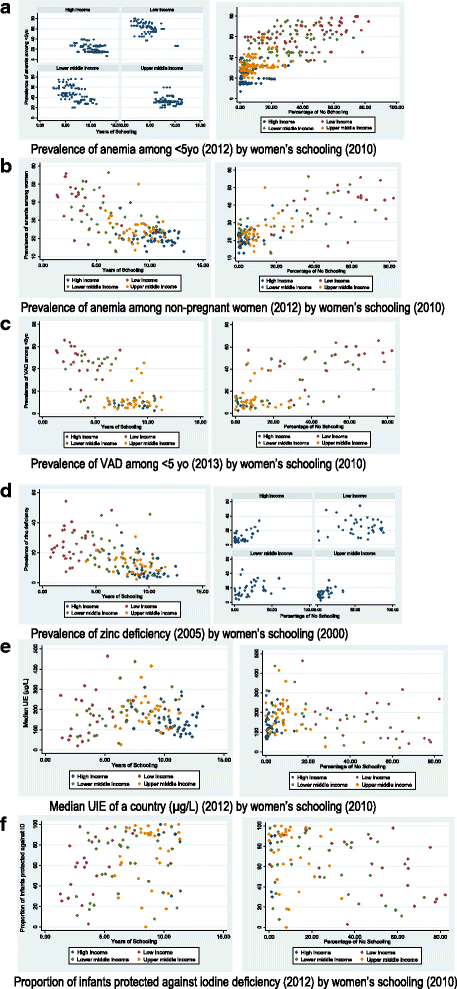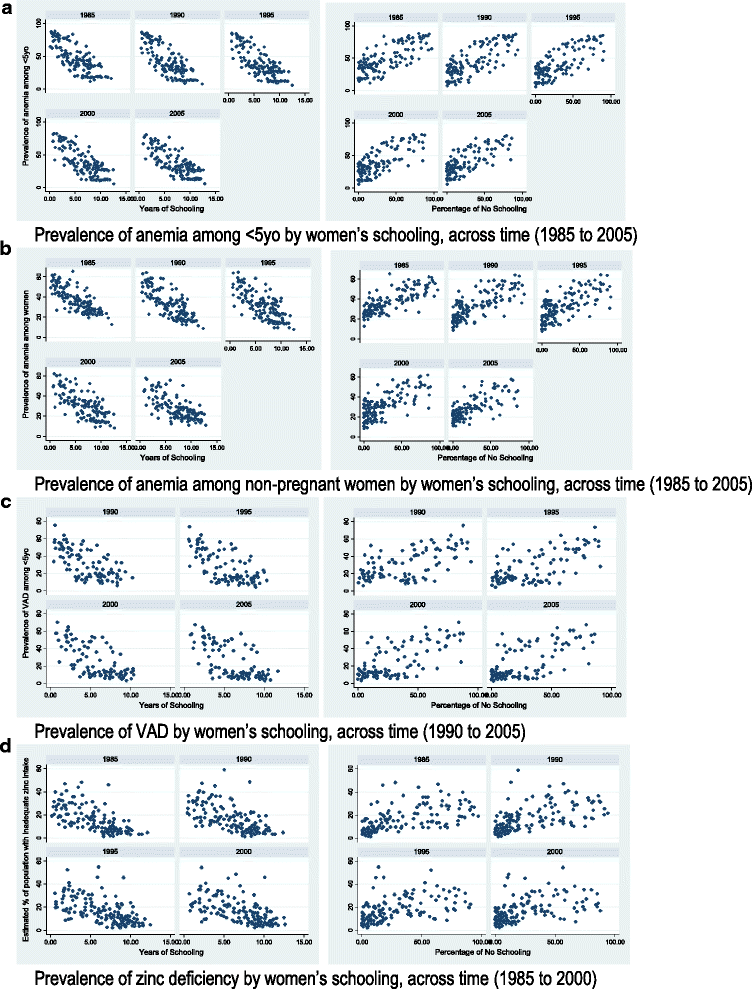Education and micronutrient deficiencies: an ecological study exploring interactions between women's schooling and children's micronutrient status
- PMID: 29636013
- PMCID: PMC5894221
- DOI: 10.1186/s12889-018-5312-1
Education and micronutrient deficiencies: an ecological study exploring interactions between women's schooling and children's micronutrient status
Abstract
Background: Formal education can be a nutrition-sensitive intervention that supports the scale-up and impact of nutrition-specific actions. Maternal education has long been linked to child survival, growth, and development while adult earnings and nutrition are tied to years in school as a child. However, less is known about the relationship between maternal education and the micronutrient status of children, women and the general population.
Methods: Using country-level data and an ecological study design, we explored the global associations between women's educational attainment and: a) anemia and vitamin A deficiency (VAD) in children aged 6-59 months; b) anemia in non-pregnant women; and c) zinc deficiency, urinary iodine excretion (UIE), and the proportion of infants protected against iodine deficiency in the general population Cross-sectional relationships (2005-2013) were assessed using linear regression models.
Results: Percentage of women without schooling was negatively associated with all outcomes. Number of years of schooling among women was positively associated with all outcomes except for UIE and the proportion of infants protected against iodine deficiency. Income level was a significant effect modifier of the effect of years of women's schooling on child anemia as well as of the proportion of women without formal education on zinc deficiency in the population. The relationship was strongest in low-income countries for child anemia, and was not significant in upper middle-income countries. For zinc deficiency, the relationship was not significant in low or lower middle income countries, which may suggest that a minimum threshold of resources needs to be reached before education can influence zinc status.
Conclusions: While relationships between maternal schooling and micronutrient outcomes vary around the globe, more schooling is generally linked to lower rates of deficiency. These findings draw policy-relevant connections between formal education and anemia and micronutrient status globally. It is necessary to examine the mechanisms through which this relationship may be working at both household and country level.
Keywords: Anemia; Economic development; Iodine; Maternal education; Micronutrient deficiencies; Micronutrients; Nutrition; Vitamin A; Women’s education; Zinc.
Conflict of interest statement
Ethics approval and consent to participate
Ethical approval was not required for this secondary data analysis. Dr. Majid Ezzati provided his global dataset on anemia and vitamin A deficiency and approval to use these data. The other datasets used for this analysis are publicly available.
Consent for publication
Not applicable.
Competing interests
The authors declare that they have no competing interests.
Publisher’s Note
Springer Nature remains neutral with regard to jurisdictional claims in published maps and institutional affiliations.
Figures


Similar articles
-
Co-existing micronutrient deficiencies among stunted Cambodian infants and toddlers.Asia Pac J Clin Nutr. 2008;17(1):72-9. Asia Pac J Clin Nutr. 2008. PMID: 18364330
-
Micronutrient Deficiencies, Over- and Undernutrition, and Their Contribution to Anemia in Azerbaijani Preschool Children and Non-Pregnant Women of Reproductive Age.Nutrients. 2018 Oct 11;10(10):1483. doi: 10.3390/nu10101483. Nutrients. 2018. PMID: 30314363 Free PMC article.
-
Risk of zinc, iodine and other micronutrient deficiencies among school children in North East Thailand.Eur J Clin Nutr. 2006 May;60(5):623-32. doi: 10.1038/sj.ejcn.1602361. Eur J Clin Nutr. 2006. PMID: 16391573
-
Adverse effects of poor micronutrient status during childhood and adolescence.Nutr Rev. 2002 May;60(5 Pt 2):S84-90. doi: 10.1301/00296640260130803. Nutr Rev. 2002. PMID: 12035866 Review.
-
Home fortification of foods with multiple micronutrient powders for health and nutrition in children under two years of age (Review).Evid Based Child Health. 2013 Jan;8(1):112-201. doi: 10.1002/ebch.1895. Evid Based Child Health. 2013. PMID: 23878126 Review.
Cited by
-
Effect of zinc-biofortified seeds on grain yield of wheat, rice, and common bean grown in six countries.J Plant Nutr Soil Sci (1999). 2019;182:791-804. doi: 10.1002/jpln.201800577. Epub 2019 Aug 29. J Plant Nutr Soil Sci (1999). 2019. PMID: 32968357 Free PMC article.
-
Traditional Societal Practices Can Avert Poor Dietary Habits and Reduce Obesity Risk in Preschool Children of Mothers with Low Socioeconomic Status and Unemployment.Behav Sci (Basel). 2021 Mar 24;11(4):42. doi: 10.3390/bs11040042. Behav Sci (Basel). 2021. PMID: 33804972 Free PMC article.
-
Contribution of socio-economic and demographic factors to the trend of adequate dietary diversity intake among children (6-23 months): evidence from a cross-sectional survey in India.BMC Nutr. 2022 Dec 27;8(1):153. doi: 10.1186/s40795-022-00655-z. BMC Nutr. 2022. PMID: 36575545 Free PMC article.
-
Coping or adapting? Experiences of food and nutrition insecurity in specialised fishing households in Komodo District, eastern Indonesia.BMC Public Health. 2021 Feb 15;21(1):355. doi: 10.1186/s12889-021-10248-3. BMC Public Health. 2021. PMID: 33588828 Free PMC article.
-
Socio-economic inequality in the nutritional deficiencies among the world countries: evidence from global burden of disease study 2019.J Health Popul Nutr. 2025 Jan 13;44(1):8. doi: 10.1186/s41043-025-00739-z. J Health Popul Nutr. 2025. PMID: 39806471 Free PMC article.
References
-
- Smith LC, Haddad L. Explaining Child Malnutrition in Developing Countries: A Cross-Country Analysis, in Food Consumption and Nutrition Division Discussion Papers, IFPRI, editor. Washington, D.C: IFPRI; 1999.
-
- Alderman H, Headey DD. The Nutritional Returns to Parental Education. IFPRI Discussion Paper, IFPRI, editor. Washington, D.C: IFPRI; 2014.
-
- Barrera A. The interactive effects of mother's schooling and unsupplemented breastfeeding on child health. J Dev Econ. 1990;34(1):81–98. doi: 10.1016/0304-3878(90)90077-O. - DOI
MeSH terms
Substances
Grants and funding
LinkOut - more resources
Full Text Sources
Other Literature Sources
Medical

